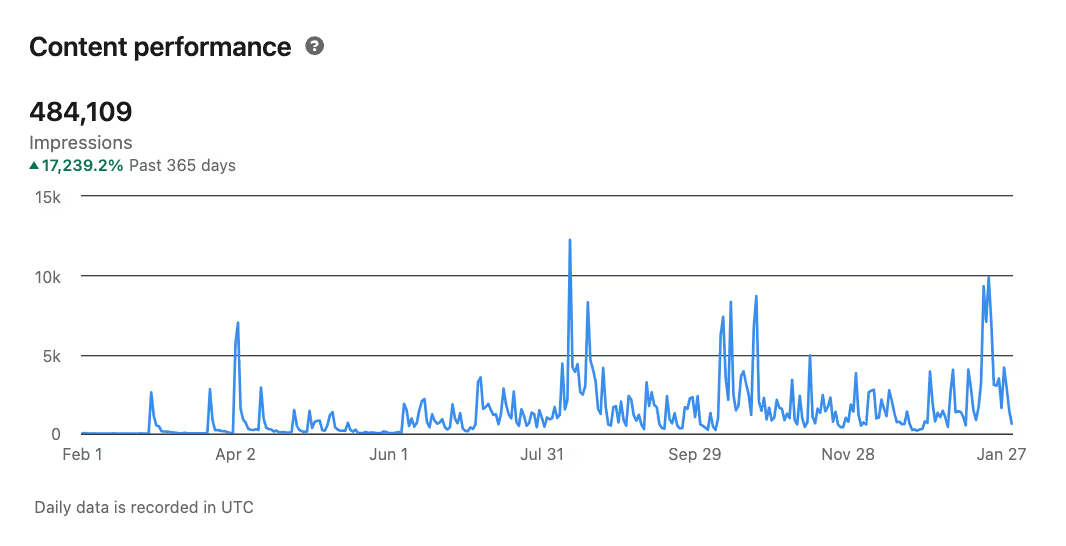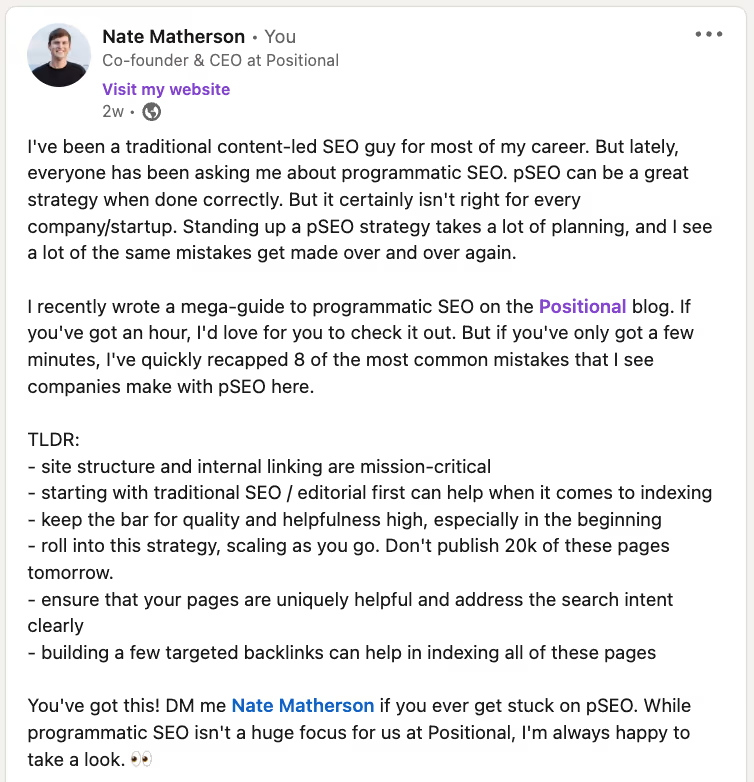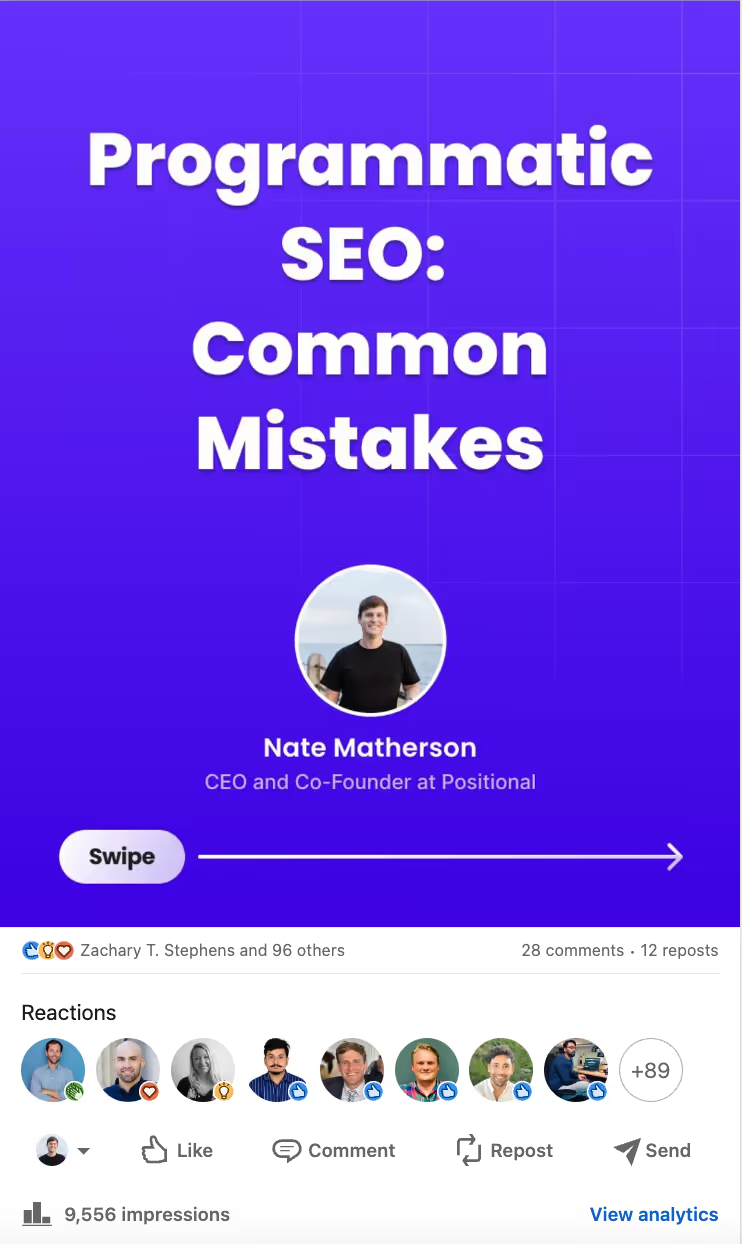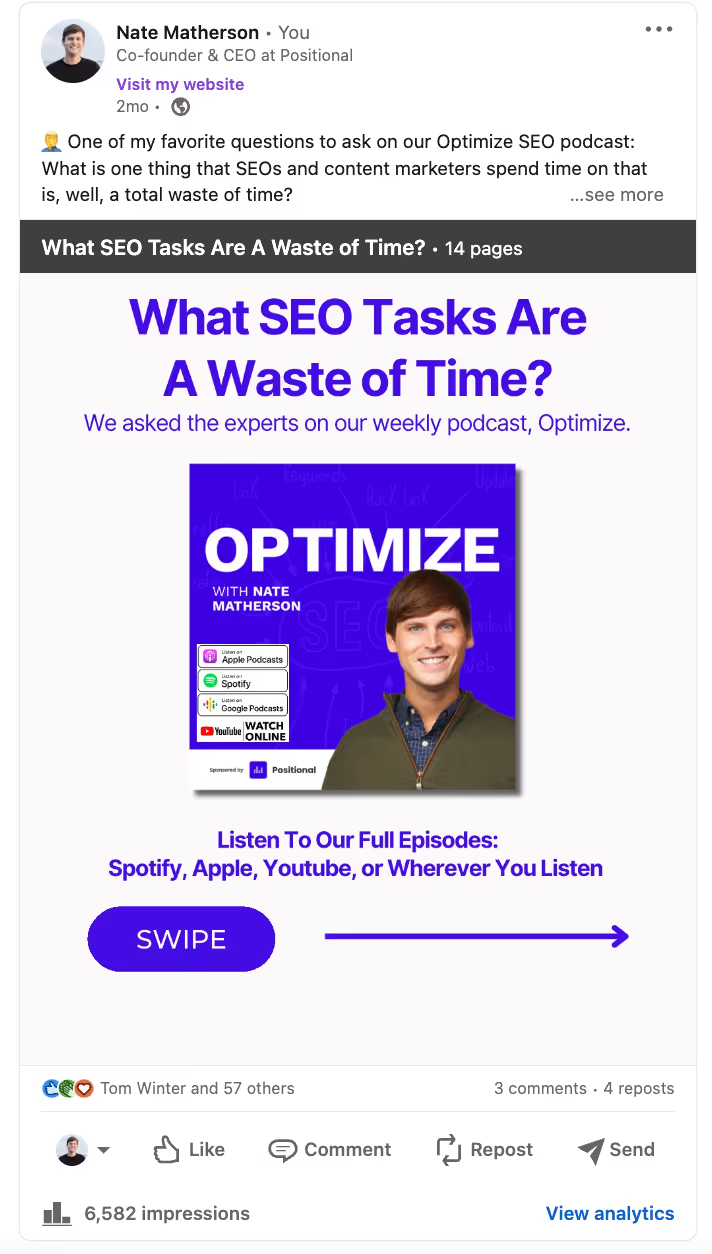A few people have recently asked me about our content repurposing strategy at Positional.
We’re creating a lot of content on our blog (primarily for organic search or SEO), and we fully expect that it will take time for this content to rank and drive traffic to our website.
But we’re a startup with only so much runway, and we’ve found that repurposing what is primarily SEO content onto other channels has been really impactful for our business.
This is by no means the definitive guide to the subject. And there are others who are crushing it with content repurposing (also known as content recycling) as well. But I thought it’d be helpful to recap what we’ve been doing with our content repurposing and distribution strategy at Positional.
What Is Content Repurposing?
To me, content repurposing means taking the content we’re already creating (for our blog, for our podcast, and so on) and repackaging it for other channels (like LinkedIn, Twitter, and our newsletter). This often involves extracting sections of longer pieces or summarizing them, and adding helpful graphics. It might also include pitching content to third parties for inclusion in their newsletters or redistributing something like a blog post as customer support documentation or sales enablement content.
In this post, I’ll run through the different strategies we’ve been using at Positional. You might even argue that the content you’re reading now has been repurposed from our other content marketing initiatives. This is by no means the definitive guide — but I hope it’s a helpful starting point for other startups and content marketing teams.
Why We Repurpose Content
The why of content repurposing is fairly straightforward. For us, it makes us more money.
Content repurposing allows us to drive more engagement with our brand and more traffic to our website. There’s little to no additional cost (if we do the work ourselves), and it requires only a couple of hours of work — for example, repurposing a blog post into a LinkedIn carousel post might take an hour, and then creating the accompanying graphic might take 30 minutes. And I’ll typically close at least one customer per week just with content repurposed on LinkedIn. This might not sound like a lot, but for us at this early stage, it is significant.
And as a founder, I have only so much time. I’ll typically spend about four to five hours writing a blog post for Positional’s blog. My pieces of content tend to be fairly long, usually about 2,000 to 3,000 words. I create this content primarily to serve a keyword or search query that we’d like to rank for in organic search. For example, we’re trying to rank for the keyword “programmatic SEO,” so I wrote this fairly long, 4,000-word blog post about programmatic SEO.
But when you’re building and scaling an SEO channel, it takes time to see results, especially for a relatively new website like Positional’s.
While I’m comfortable making the long-term bet of investing in our SEO channel, I need more customers now — like, right now.
At Positional, we’re working to take our fairly long blog posts and repackage them into shareable content on platforms where our ICPs are. At Positional, we primarily sell to go-to-market teams, marketers, SEOs, and startup founders. These folks typically hang out on Twitter and LinkedIn, and they often actually like receiving email newsletters.
These platforms are very effective for quickly getting additional distribution for our content pieces. But for some startups, platforms like Reddit or Hacker News might be a better fit (and might require different formats).
As of this writing, I have about 8,500 followers on LinkedIn, 2,000 followers on Twitter, and roughly 1,600 subscribers to our weekly newsletter. On LinkedIn, each of my repurposed carousels typically generates between 5,000 and 10,000 impressions. And our weekly newsletter typically gets opened between 45% and 55% of the time, driving 100 or so visitors back to our website every week.
In addition to repurposing our blog content, we often repurpose content from our weekly SEO podcast, Optimize, to other channels. And we often repurpose our podcast content back to our blog posts. (More on this a bit later.)
As with SEO, getting initial momentum on social platforms like LinkedIn can take some time, but then things start to compound. For example, here is a graph of my LinkedIn impressions over the past year:

And here is a graph of my new LinkedIn followers over the past year:

As we begin 2024, we’re planning to do two things: create a lot more content and repurpose a lot more content
And as with SEO, it’s critically important to make sure that all of this content is fantastic.
Choosing which content to repurpose can be challenging. But we’re taking the approach that we want to repurpose basically every piece of content we create to another platform or channel. I particularly love repurposing very long-form blog content into quick carousels on LinkedIn. But there are many other ways to repurpose content.
Types and Examples of Content Repurposing (That We’re Doing)
There are many different ways to repurpose your content and many channels to place it on. At Positional, as I’ve said, we’ve focused primarily on LinkedIn, Twitter, and newsletters. We also work hard to repurpose our content for customer support and the sales process.
Repurposing Content for LinkedIn Carousels and Twitter Threads
TLDR: You should repackage your longer-form blog content into easily digestible LinkedIn carousels and Twitter threads. These are great for driving increased engagement with your posts. You’ll need a good-looking template, and you should post from your personal accounts for the best performance.
I love SEO, but I’ve recently fallen in love with LinkedIn carousels. LinkedIn technically removed the carousels feature, but you can still post PDFs to LinkedIn and accomplish something similar.
Earlier, I mentioned the carousel that I created on programmatic SEO (or pSEO). This carousel was repurposed from a much longer blog post I created on the topic. (Here’s the carousel on LinkedIn.) There are two parts to my carousel posts:
Part 1: The Copy Before the Graphic

In this part, I try to write engaging copy and provide LinkedIn users a reason to expand my full post as they’re scrolling. I’ve found that the more personal the text is, the better. For example, in the copy here, I mention that I’m a “traditional content-led SEO guy,” and I believe that will resonate with a lot of SEOs. And I give readers a reason to expand my post by suggesting that pSEO “can be a great strategy when done correctly.” Which might lead them to ask, “Oh no, what might I mess up?”
Part 2: The Graphic

This carousel contains 15 slides (that is, the PDF had 15 pages) that the user can scroll through. I’ve encouraged LinkedIn users to keep swiping.

In general, this post style generates significantly more engagement than most of my text-based posts on LinkedIn. This post on pSEO generated about 10,000 impressions and 97 likes. From there, I’ll try to connect with any of the folks who have engaged with my post that I’m not connected with yet.
We run a similar playbook with our podcast. For example, we repurposed excerpts from our podcast into this LinkedIn post: “What SEO Tasks Are a Waste of Time?”

I featured several guests from our podcast, tagging them in the process and then getting them to reshare the content to their networks. And I do this repeatedly, extending my own audience with the help of our guests. This post didn’t do as well; it got about 6,500 impressions and 58 likes. But this was before we revamped our carousel templates. We noticed a significant lift in the performance of our LinkedIn posts after we made our templates look more professional and beautiful.
Don’t forget to respond to everyone who comments with a substantial reply. Don’t reply back with “thanks”; try to write a more thoughtful and relevant reply. The better you reply to folks who comment, the more engagement LinkedIn will want to give you. And don’t be afraid to respond to people who reply with a follow-up question, prompting them to enrich the comments section with even more good content.
As another pro tip, getting a LinkedIn Community Top Voice badge is relatively easy, which might help improve engagement and, at minimum, will make your profile look more credible.
A lot of this holds true on Twitter as well. The biggest difference is that you can’t post a carousel (at least to my knowledge). Instead, I’ll break each individual slide from the carousel into a tweet within a thread. For example, I repurposed some excerpts from our podcast into this tweet thread.
Personally, I don’t do nearly as well on Twitter as I do on LinkedIn. But repurposing content for Twitter, too, requires minimal effort.
Repurposing Content for Our Weekly Email Newsletter
TLDR: Our weekly newsletter is sent automatically every Friday. It pulls in all of our new content, blog posts, and podcasts from RSS feeds into a pre-built template. I kid you not; it took us about one hour to set this up, and we are now up to 1,670 subscribers and open rates of about 45% to 55% each week.

I’m sure we could do this better (for instance, with a more visually pleasing template and more images). But we just wanted to get something out there, and we didn’t want to have to spend time every week updating a newsletter to send.
This incredibly simple template is working well for us, and we’re driving about 100 visitors back to our website every week.
Startups always ask me, “How much content should we create?”
I generally recommend getting into a weekly cadence because it allows you to do something like this (a weekly newsletter) and sets an expectation with your audience that they can expect to see something helpful from you each week.
I’m sure that once we hit a few thousand subscribers, we’ll spend a bit more time on the newsletter template and design. But for right now, this is all we need.
Repurposing Content for Third-Party Newsletters (Pitch Them)
TLDR: You can actively pitch other newsletters in your industry to include your content (for free).
Before pivoting to Positional, Matt and I were building ContainIQ, a K8s observability toolset. We had a lot of success pitching our blog posts for inclusion in other people’s newsletters.
If you’re in a space where creating fantastic content is really hard (like devtools), there’s probably a shortage of good, relevant content on the internet. And the folks running weekly or even daily newsletters are constantly searching for awesome content to include in their newsletters.
Make their life easy.
My script looked like this (exactly):

And Gareth would go on to include a number of our blog posts in his newsletters. We made Gareth’s life easier by providing him with fantastic content for his readers.
We repeated this process each month with four or five newsletters in our space. Once you’ve built a rapport with the person running the newsletter (that is, after they’ve included you once), it’s often a lot easier to get them to include you again.
These newsletter placements were great for driving traffic to our website, and we’d accumulate backlinks to our website in the process, as many people republish their newsletters to their websites.
And I’m going to fill you in on a little secret. The people running newsletters frequently copy each other. If you can get yourself included in one newsletter, the odds are that other people who are running newsletters will copy and paste your URLs into their newsletters.
We’ve gone on to run a similar playbook at Positional — although in our current industry, there’s no shortage of great content, so getting included seems to be a bit harder.
Repurposing Podcasts into Blog Content
TLDR: We are actively repurposing excerpts from our podcast into our blog content to make our content more helpful and to demonstrate E-E-A-T.

For example, I recently wrote a blog post on how to hire content writers. We talk about hiring content writers on our podcasts all the time, including the costs of doing so. I plugged excerpts from four of our guests into the section of this article where we discuss the costs of creating content.
We are doing three things here:
- We are plugging our podcast episodes into our blog content. Hopefully, our blog readers will end up clicking over to the podcast episode with that particular guest, where we talk about the subject they’re currently reading about.
- We are enriching our article with quotes and unique perspectives from actual experts. You’ll hear a lot about Google’s E-E-A-T guidelines for quality raters. In short, Google wants to see that actual experts are writing your content and that your content has experience, expertise, authoritativeness, and trustworthiness. We are showing E-E-A-T by quoting experts.
- We are making our articles more helpful for readers in the hopes that they will keep reading and enjoying more content from our website — which sends a positive signal to Google.
Repurpose Content for Customer Support and Sales Enablement
TLDR: Repurposing content to other channels for increased engagement and traffic is great, but you can also repurpose your content to better equip your customer support and sales teams. This is a really big focus for us at Positional.
As SEOs, we often spend a lot of time researching or determining which keywords or search queries to serve with webpages. Of course, plenty of tools are available for keyword research, including those from Positional, Ahrefs, and Semrush. These tools provide lots of keyword ideas, including relevant data like search volume and competition for each keyword, and they also allow you to do competitor research.
But before you use a keyword research toolset, I’d suggest starting with the questions (or keywords) you keep hearing from customers and potential customers (via customer support or sales teams).
Positional’s blog covers a variety of topics related to content marketing and SEO. Nearly every piece of content we’ve created was prioritized to serve a customer support question or enable our sales process. We are also hitting specific keywords within our pieces — making the bet that other potential customers will have similar questions (keywords).
For example, I tend to get a lot of customer support questions about title tags, so I wrote this quick blog post recapping title tag best practices. Redistributing our content in the customer support channels saves me approximately 30 to 60 minutes every single day.
As another example, in the sales process, I’m often asked about the value or importance of internal linking. So, I wrote a fairly in-depth guide on why internal linking is important, and we backed that up with a case study highlighting one of our clients using Internals, Positional’s toolset for internal linking.
I almost didn’t include this section because repurposing content to customer support and sales isn’t actually republishing content. But at least to me, content repurposing doesn’t always need to mean republishing content, although it certainly can. In a broader sense, I think content repurposing includes any method of extracting additional usefulness from the content that you’ve already created. And our distribution channels here would largely be the shared Slack channels that we’ve set up with the majority of our customers.
Repurposing Blog Posts for Video and Vice Versa
TLDR: If you’re already creating fantastic video content, you should absolutely repurpose that content into your blog posts. This will improve the uniqueness of your pages and increase engagement. I bet it will improve conversion rates, too.
Many of you might know Aakash Shah from Wyndly. Aakash was kind enough to be one of the first guests on the Optimize podcast.
On the podcast, Aakash and I chatted about the awesome success that Wyndly has had with content marketing and SEO over the last couple of years. One of the things I found most interesting was Aakash’s approach to repurposing video content into their blog pages and using video content as a keyword research tool.
On the Wyndly site, you’ll see that they include short-form video clips explaining what are often complex medical topics very clearly:

Wyndly is actively repurposing their short-form video content from TikTok and other platforms back into their blog content. Aakash actually ran an experiment and found that by introducing video content into their blog pages, they saw a substantial lift in the performance of those pages in organic search. And that makes sense. Aakash is making his pages more unique and more valuable, and he’s likely improving user experience metrics like time on page, scroll depth, and bounce rate — signals that Google uses to determine whether people like your page.
Another thing I found really interesting is that Aakash uses engagement on TikTok as an indicator of which blog posts they should create. If, for example, they see a video perform really well on TikTok, that tells them that they should create a longer-form blog post on the same topic. This has helped Aakash uncover a large number of long-tail keywords that might otherwise be missed by keyword research tools.
It is important to note that Google has gotten increasingly good at identifying off-page signals (such as traffic from a newsletter or momentum on TikTok) and using that data to support movements in organic search rankings. Aakash actually found that every time they went viral on TikTok, they would see a noticeable spike in the performance of all Wyndly pages in organic search.
Other Types of Content Repurposing
There are so many other types of content repurposing. Here are a few examples of other methods I’ve used in the past:
- You could repurpose a collection of blog posts on a given topic into a more substantial ebook.
- You could repurpose blog content into checklists or downloadable templates, as we do with our content outlines and editorial calendar pages.
- You could repurpose your blog content into standalone graphics or infographics (not carousels), on platforms like LinkedIn and Twitter. You could also include those infographics back into your blog pages, which is an effective way to build backlinks over time. We chatted about this at length on a recent podcast with Ann Smarty.
- You could syndicate your content to other publishers. This was something that we did at our first company. For example, we syndicated lots of our blog content to local and regional newspapers that, frankly, just need more content on their website every day.
- You could repurpose transcripts from your podcast or videos into standalone content pages on your website.
I’m sure that I forgot to mention at least 20 other ways to repurpose content — webinar recordings and transcripts can be repurposed in lots of ways. But again, this post has largely been written from my own experience.
Final Thoughts
Content repurposing is hard to define because there are many different ways to do it and many distribution methods to try.
If you or your team is already spending significant time creating content, it’s important to think critically about how this content might serve another purpose and provide additional value for the top of the funnel, the customer support team (me), and the sales team (me again).
This blog post was just published on our blog, but I bet that I could actually repurpose this blog post about content repurposing to LinkedIn and in our newsletter. Stay tuned!
How have you had success repurposing content? What did I miss?
I’d love to hear from y’all.
.avif)




